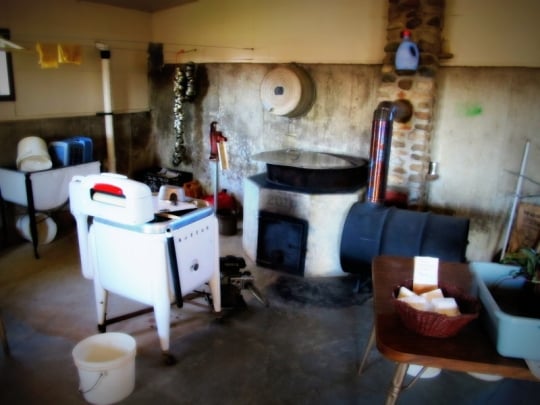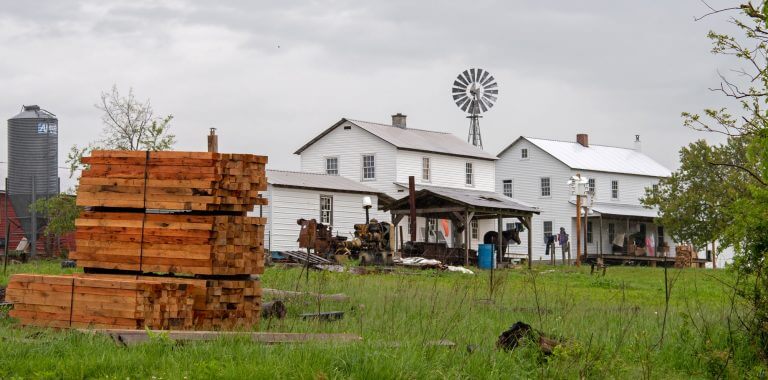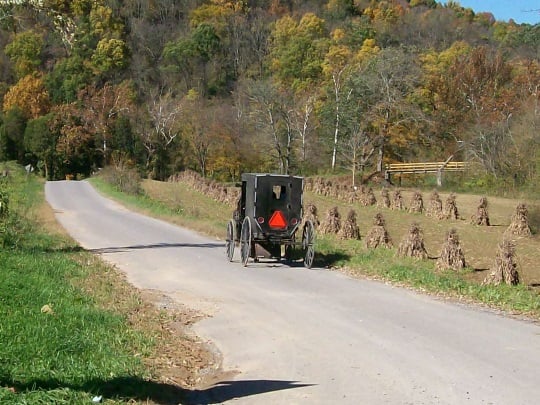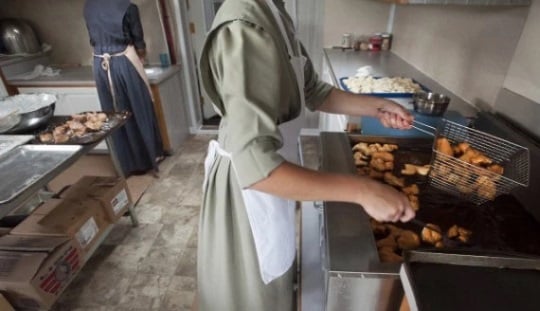Inside an Amish Home: Heat & Wash

A photo taken by reader Rose in the Kingston/Dalton Wisconsin Amish community. What do you notice?


A photo taken by reader Rose in the Kingston/Dalton Wisconsin Amish community. What do you notice?

Similar Posts

We’ve got a selection of photos from a Swartzentruber Amish settlement in Missouri today. This is Shannon County; this is in the vicinity of Summersville and Hartshorn. The photo collection is by Don Burke, who has passed through this community several times over the years. The community was started in 2006 according to the State & County Amish listing. It’s a single church district. We…

The atypical Amish community at Pearisburg, Virginia (Giles County) has been described as “unique”. I’ve never been there, but we’ve heard a lot about Pearisburg–the oldest of Virginia’s half-dozen Amish settlements–from readers and contributors over the years. First, Rich Stevick has shared about this mountain settlement a few times. How about this unusual courtesy for non-Amish visitors: Several years ago at a wedding in Pearisburg, VA, we had the…

Did you know that a number of Amish call Maine home? Among the handful of settlements in the Pine Tree State are the Amish at Unity, Maine (Waldo County), an atypical group for several reasons. Everything I’ve heard about this community suggests it’s a nice little place with a few businesses and which seems to be quite friendly to outsiders (that of course is not what makes it unusual). All images…
Pennsylania Amishman John Stoltzfus has agreed to answer some reader questions. Last week’s concerned Amish medical care and use of vaccinations. As before, John notes that he will take a general approach to his answers, keeping in mind that communities differ. Today’s question is on Amish migration: How do settlements get started? Is it just people from previous settlements moving and starting them in other…

The Old Order Amish congregation of Pinecraft in Sarasota, Florida, does not use the horse-and-buggy. Amish in this congregation get around by way of bike as well as large adult ‘tricycles’. Pinecraft is mostly made up of older residents and seasonal visitors. Read more on the Pinecraft, Florida Amish. Pinecraft is also home to numerous attractions including restaurants and beaches. There are also a number…
Last week’s Lancaster County favorites post has been getting some nice suggestions. Lot of food places and Amish businesses, plus some rather off-the-beaten path recommendations like Amos Hoover’s library and the Lititz area. Lindsay asked if we could do the same for Elkhart and Lagrange Counties in Indiana (i.e. Shipshewana, Middlebury, and so on). I’d even open it up to nearby Nappanee, and for…
22 Comments
Is that a wringer dryer? You put the clothes in, turn a hand crank and it squeezes water out? Later you put the clothes out on the line to dry. No electricity. I think my mom had one when I was little but then we got better off and got a “real” dryer…
Is that a small motor on the ground to power the wringer washer?
I am so proud that I am so humble.
heat source?
Ruth uses the same kind of machine for washing. I’m wondering about the vertical pole just the other side of this. Looks like possibly a pump for water? And what’s that large thing behind all of this, maybe a heat source? Seems to have a chimney flue and maybe some kind of heating compartment? These are wild guesses!
I believe the large thing behind is a kettle stove. My Swartzentruber Amish friends in Randolph, MS have one. I was told it heats the water for doing the washing. They power their wringer washer with a gasoline motor, and of course hang their clothes on the line. The wringer washer is not hard to use, I have one and love it in the summer. Really helps to keep my power bill low, and nothing smells better than fresh wash off the line!
I am so thankful for my washer & drier.. I’d love to hang my clothes outside & used to when I lived in the country but it’d sure be a pain on some of these snowy winter days.
hanging out wash
My local Amish neighbors hang out (on the regular clothes lines)on any sunny dry but cold days. But if its raining/sleeting/snowing, or just too cold, they string up ropes in the house (and/or on the covered porch for smaller “loads”)- the hooks are always there in place, so all they have to do is string the ropes onto them and up go the laundry. Sara
wash day
Sometime I think us people in the world has it to easy. People in the world, is thanful what we have. I love JESUS !
Memories
Boy, seeing that picture brought back memories from when I was growing up. We used an old wringer washer like that until I was in Jr. High School, the only reason we upgraded to an automatic washer was because we couldn’t get parts for the wringer machine anymore & we didn’t have a dryer until after I was grown & gone.
I wish I had one of those old wringer machines now. Loved them. I do hang my clothes out on the clotheslines though
Blue barrel appears to be part of a heating source. PVC pipe in wall looks to be a drain, but for what purpose? I don’t see a floor drain for the washer, but do see buckets around. Do they have to haul the used water by bucket? Or is the sump pump just out of sight—PVC pipe is rising from it–my guess (like at my house).
It looks like something green growing in the blue plastic tub on the table. What is it? (It also reminds me that I’ll need to start some vegetable seeds in a couple of weeks!)
Alice Mary
Rose writes me that this is actually the same room as the mud room photo of a couple weeks ago: https://amishamerica.com/inside-an-amish-home-muddy-pairs/
Somewhat off topic, but clothes dry just fine inside in the winter. We have a drying rack that I put a wash on in the evening before I go to bed and the load is almost always ready for folding in the morning before work. I set it up in front of the masonry heater in the living room and the gentle heat and dry winter air do the rest. Overnight drying also keeps the laundry out of the way during the day. During other times of year clothes dry better outside (during the day) so that’s where they go then. We have a dryer, but it goes weeks without use.
Check out this book.
http://www.amazon.com/Amish-Christian-Addiction-Conviction-Faith-Power-Adam-Fischer/dp/1449759467/ref=sr_1_1?ie=UTF8&qid=1361511366&sr=8-1&keywords=amish+to+christian
A field stone chimney. That must have been fun to build. I wonder what is in the bottle setting on that shelf on the chimney? What needs warming like that?
In the far corner hangs a string with a LOT of canning lid rings on it.
I wonder if the pitcher pump is well water or cistern rain water. Rain water is a lot softer and make much better clothes and people washing water.
What jumped out at me was the bottle of fabric softener by the chimney 🙂
Seeing that wringer washer makes me nostalgic, but it also reminds me how much better-made the old products were. My husband is parts mgr. at an appliance store; he says the new washers are constantly breaking down, some when they’re only a few months old. They are very expensive appliances but they’re really junk.
Barbara, I too noticed a fabric softener bottle on the shelf by the chimney. Softener can thicken if it gets too cold (thanks, Lance for the warming idea). The washer lid is propped open to dry, a rinse tub (on caster wheels?) holds a laundry basket and buckets, a galvanized washtub or “vesh tsuvvah” is hanging on the wall (useful for pre-soaking), and I see a wood-fired water heater (was it built in 2011?). A fire can be built under the big black kettle (cast iron?) that is filled with water. I don’t know what the purpose is of the 55-gallon drum on its side.
Where’s the soap? In the basket?
The large item at the back looks very much like the “copper” my grandma in Australia used to wash her clothes in until the 1970’s. It was located in the wash house in the back yard and on Monday wash day grandpa would fill it with water and light a fire in the box underneath. When the water was hot the clothes went in to be boiled. She had concrete laundry troughs along side and one of these was filled with rinse water. The laundry was pulled from the copper with a stick, rinsed then put through a wringer (like on the washing machine) that was hand cranked. The wringer sat between the twin concrete troughs.
The wash then went outside to dry or into the back porch if the weather was wet.
When grandma was in her 70’s she and grandpa installed plumbing into the back porch and bought a washing machine and put in an inside toilet there too. Thanks for the opportunity to reminisce about this.
To me the 55 gallon drum looks like it may be a home made wood or coal stove when more heat is needed on cold Wisconsin days.
Ban hammer time
Morons will be morons. Drop the hammer on ’em Erik.
Spam mail
Okay I know this is entirely off topic and I do apologize.
This morning I received spam mail regarding Amish furniture. I recognize the address for unsubscribing. It’s spam mail. Please if you get one of those just delete it. Don’t respond! Spammers love to get return mail asking to unsub–it tells them the account is live!
Just thought I’d mention it in case others get this type of mail…
I now return you…
Margaret, no need to apologize and thank you for mentioning this
Wringer washing machine
It’s at the Bontrager farm that has 5 acres with produce they sell for income. It’s a stop on my tours there for the past 20 years. Their newly married daughter and husband live in a building on the farm.
Richard